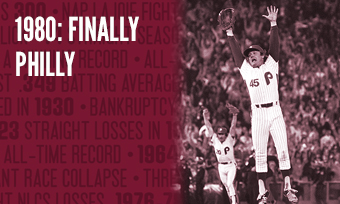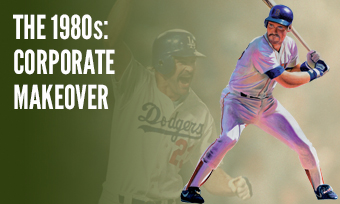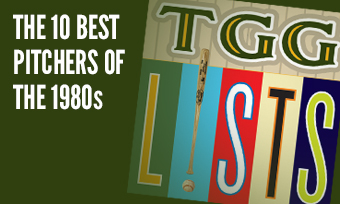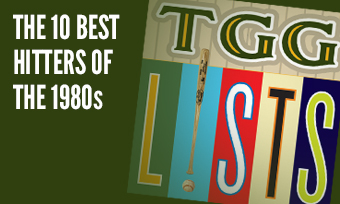The Yearly Reader
Leaders and Honors, 1980
Our list of baseball’s top 10 hitters and pitchers in both the American League and National League for the 1980 baseball season, as well as the awards and honors given to the game’s top achievers of the year.
The National League’s Top 10 Hitters, 1980
Bold type in brick red indicates league leader.
1. Mike Schmidt, Philadelphia
Key Numbers: .286 average, 104 runs, 25 doubles, 8 triples, 48 home runs, 121 RBIs, 89 walks, 12 stolen bases, 13 sacrifice flies, .624 slugging percentage.
With subpar batting averages in 1978-79 that threatened to make him the next Dave Kingman, Schmidt awoke and initiated a reign of supremacy among NL hitters; his slugging percentage was nearly 100 points higher than second-place Bob Horner.
2. Keith Hernandez, St. Louis
Key Numbers: .321 average, 111 runs, 191 hits, 39 doubles, 8 triples, 16 home runs, 99 RBIs, 86 walks, 14 stolen bases, .408 on-base percentage.
All that separated Hernandez from his second straight NL batting title was the Cubs’ Bill Buckner, who hit just three points higher.
3. Andre Dawson, Montreal
Key Numbers: .308 average, 96 runs, 178 hits, 41 doubles, 7 triples, 17 home runs, 87 RBIs, 6 hit-by-pitches, 34 stolen bases.
Don’t blame Dawson, still in his early, speed-trumps-power phase of his career, for keeping the Expos from overtaking the Phillies in the NL East; he hit .319 with four homers in 18 games against them.
4. Ken Griffey, Cincinnati
Key Numbers: .294 average, 89 runs, 28 doubles, 10 triples, 13 home runs, 85 RBIs, 23 stolen bases, 1 caught stealing.
Griffey—senior, not junior—remained one of the few stars within the Big Red Machine to still be running on all cylinders.
5. Ted Simmons, St. Louis
Key Numbers: .303 average, 84 runs, 33 doubles, 21 home runs, 98 RBIs.
The future Hall of Famer played his 13th and final season in St. Louis, finishing with a .298 average that’s the highest among catchers in Cardinals history.
6. Jack Clark, San Francisco
Key Numbers: 127 games, .284 average, 77 runs, 20 doubles, 8 triples, 22 home runs, 82 RBIs, 74 walks.
Clark’s numbers, most of which were on their way to setting career highs, were curtailed after having his hand broken by a pitch late in the season.
7. Jose Cruz, Houston
Key Numbers: .302 average, 79 runs, 185 hits, 29 doubles, 7 triples, 11 home runs, 91 RBIs, 36 stolen bases.
Cruz remained the epitome of a punchless yet feisty Astros offense, one of five Houston hitters with at least 10 homers—though none of them hit more than 13.
8. Dale Murphy, Atlanta
Key Numbers: .281 average, 98 runs, 27 doubles 33 home runs, 89 RBIs, 133 strikeouts.
Failing as a catcher, Murphy finally became a success story after the Braves transitioned him to the outfield.
9. Steve Garvey, Los Angeles
Key Numbers: 163 games, .304 average, 78 runs, 200 hits, 27 doubles, 26 home runs, 106 RBIs.
Garvey managed to stay focused on baseball and collect 200 hits for the sixth time in seven years while his wife publicly bashed him.
10. Cesar Cedeno, Houston
Key Numbers: 137 games, .309 average, 32 doubles, 8 triples, 10 home runs, 73 RBIs, 48 stolen bases.
Solid comeback effort for Cedeno, who hit over .300 for the first time since 1973 while racking up terrific stolen base numbers despite bad knees.
The American League’s Top 10 Hitters, 1980
1. George Brett, Kansas City
Key Numbers: 117 games, .390 average, 87 runs, 175 hits, 33 doubles, 9 triples, 24 home runs, 118 RBIs, 15 stolen bases, .454 on-base percentage, .664 slugging percentage.
Lost in Brett’s pursuit of .400 was that he became the first player since 1950 to average at least one RBI per game.
2. Cecil Cooper, Milwaukee
Key Numbers: .352 average, 96 runs, 219 hits, 33 doubles, 25 home runs, 122 RBIs, 17 stolen bases.
Had it not been for Brett, Cooper—the majors’ biggest unsung talent since Vada Pinson—might have caught some rays in the national spotlight.
3. Ben Ogilvie, Milwaukee
Key Numbers: .304 average, 94 runs, 180 hits, 26 doubles, 41 home runs, 118 RBIs, 19 intentional walks, 11 stolen bases.
At 170 pounds, Ogilvie became the lightest player to hit 40 home runs since Mel Ott.
4. Rickey Henderson, Oakland
Key Numbers: .303 average, 111 runs, 179 hits, 9 home runs, 53 RBIs, 117 walks, 100 stolen bases, 26 caught stealing.
While two other major leaguers (Ron LeFlore and Omar Moreno) topped 90 stolen bases, the 21-year-old Henderson broke Ty Cobb’s AL season mark and became the first in the Junior Circuit to reach 100—with 34 of those over his last 28 games alone.
5. Reggie Jackson, New York
Key Numbers: .300 average, 94 runs, 41 home runs, 114 RBIs, 83 walks.
For the only time in his career, Jackson hit .300 (actually, it was .2996), while he topped 40 homers for the first time since his breakout 1969 performance.
6. Willie Wilson, Kansas City
Key Numbers: .326 average, 705 at-bats, 133 runs, 230 hits, 28 doubles, 15 triples, 3 home runs, 49 RBIs, 79 stolen bases.
Wilson became the AL’s first switch-hitter to collect over 200 hits since Buck Weaver for the 1920 White Sox.
7. Robin Yount, Milwaukee
Key Numbers: .293 average, 121 runs, 179 hits, 49 doubles, 10 triples, 23 home runs, 87 RBIs, 20 stolen bases.
Already in his seventh season as he turned 25, Yount dialed up the power and hit over 20 home runs—let alone 10—for the first time in his career.
8. Eddie Murray, Baltimore
Key Numbers: .300 average, 100 runs, 186 hits, 36 doubles, 32 home runs, 116 RBIs.
The switch-hitter, now fully immersed as the Orioles’ top offensive threat, hit over .300 with 100 RBIs and runs each for the first of two times (1983) in his career.
9. Al Bumbry, Baltimore
Key Numbers: .318 average, 118 runs, 205 hits, 29 doubles, 9 triples, 9 home runs, 53 RBIs, 78 walks, 44 stolen bases.
Fully recovered from a devastating 1978 leg injury that nearly ended his career, the veteran outfielder scored his best year yet, leading to his lone All-Star Game appearance.
10. Al Oliver, Texas
Key Numbers: 163 games, .319 average, 96 runs, 209 hits, 43 doubles, 9 triples, 19 home runs, 117 RBIs.
The 33-year-old former Pirate, who seemed to be getting better with age, had his second hat trick of home runs in as many years—even though he didn’t hit more than 19 in either one of those seasons.
The National League’s Top 10 Pitchers, 1980
1. Jerry Reuss, Los Angeles
Key Numbers: 2.51 ERA, 18 wins, 6 losses, .750 win percentage, 3 saves, 2 blown saves, 37 appearances, 29 starts, 6 shutouts, 229.1 innings, 40 walks, 23 grounded into double plays.
Winner of 10 total games from 1978-79, Reuss rediscovered himself and threw the year’s only no-hitter.
2. Steve Carlton, Philadelphia
Key Numbers: 2.34 ERA, 24 wins, 9 losses, .727 win percentage, 38 starts, 13 complete games, 304 innings, 90 walks, 286 strikeouts, 17 wild pitches, 7 balks.
Pitchers threw over 300 innings 40 times during the 1970s, but only once since—by Carlton in 1980.
3. Don Sutton, Los Angeles
Key Numbers: 2.20 ERA, 13 wins, 5 losses, .722 win percentage, 1 save, 31 starts, 212.1 innings, 47 walks, 24 stolen bases allowed.
After a series of relatively disappointing years that suggested a slow fadeout was in the works, Sutton refreshed and grabbed his first and only ERA title.
4. Steve Rogers, Montreal
Key Numbers: 2.98 ERA, 16 wins, 11 losses, 37 starts, 14 complete games, 281 innings, 27 stolen bases allowed.
Sign of the times: Rogers’ 14 complete games was, to date, the fewest ever notched by a NL leader. It was just the beginning of a glacial but definitive trend.
5. Vern Ruhle, Houston
Key Numbers: 2.37 ERA, 12 wins, 4 losses, .750 win percentage, 28 appearances, 22 starts, 159.1 innings, 29 walks.
Knocked around between the minors and the parent club for the previous few years, Ruhle was ramped up to full-time rotation duty after J.R. Richard’s career-ending stroke in mid-July and answered the call with a 7-2 record and 1.86 ERA over his last 15 starts.
6. Vida Blue, San Francisco
Key Numbers: 2.97 ERA, 14 wins, 10 losses, 31 starts, 224 innings.
After a horrible 1979 in which he posted the NL’s worst ERA (5.01), Blue quickly rebounded to vintage Vida form and put together the league’s fourth best figure.
7. Jim Bibby, Pittsburgh
Key Numbers: 3.32 ERA, 19 wins, 6 losses, .760 win percentage, 34 starts, 238.1 innings, 30 stolen bases allowed.
Bolting to a 13-1 start, the 35-year-old Bibby proved that the Pirates had been wasting his time the previous two years being shuffled in and out of the bullpen.
8. Joe Niekro, Houston
Key Numbers: 3.55 ERA, 20 wins, 12 losses, 36 starts, 256 innings, 34 stolen bases allowed.
Starting the 163rd game, a playoff against the Dodgers to decide the NL West, gave Niekro the opportunity to capture his second straight 20-win season; he made good on it, going the distance with just an unearned run allowed.
9. Frank Pastore, Cincinnati
Key Numbers: 3.27 ERA, 13 wins, 7 losses, 27 starts, 184.2 innings, 42 walks.
This would be Pastore’s only winning season among five as a Reds starter; but he was hardly an Astros killer, going 0-4 with a 7.30 ERA against Houston.
10. Rick Camp, Atlanta
Key Numbers: 1.91 ERA, 6 wins, 4 losses, 22 saves, 2 blown saves, 77 appearances, 108.1 innings.
Camp walked into Atlanta camp without a roster spot, and finished the year as the NL’s most effective closer.
The American League’s Top 10 Pitchers, 1980
1. Mike Norris, Oakland
Key Numbers: 2.53 ERA, 22 wins, 9 losses, .710 win percentage, 33 starts, 24 complete games, 284.1 innings, 4 balks.
Norris, who’d seen it all since joining the A’s in 1975, became the top dog on Billy Martin’s ironman staff; five times, he pitched at least 10 innings—and won four of those starts.
2. Tommy John, New York
Key Numbers: 3.43 ERA, 22 wins. 9 losses, .710 win percentage, 36 starts, 6 shutouts, 265.1 innings, 56 walks, 33 grounded into double plays.
Give my regards to Dr. Frank Jobe: The 37-year-old John ran his post-Tommy John surgery record to 90-44 and led the league in shutouts for the first time since doing it back-to-back, way back in 1966-67.
3. Rick Langford, Oakland
Key Numbers: 3.26 ERA, 19 wins, 12 losses, 33 starts, 28 complete games, 290 innings, 64 walks, 23 grounded into double plays.
Like Mike Norris, Langford excelled under the A’s exhaustive start-‘em-and-finish-‘em rotation mindset before mid-career burnout. Evoking Robin Roberts, Langford completed 22 straight starts, and 25 of 27—with the two “non-completes” being outings of 8.2 and 10 innings.
4. Rudy May, New York
Key Numbers: 2.46 ERA, 15 wins, 5 losses, .750 win percentage, 3 saves, 41 appearances, 17 starts, 175.1 innings, 39 walks.
Returning to the Yankees after short stays with the Orioles and Expos, May spent the season’s first half exclusively in the bullpen before a midseason promotion to the rotation—where he won his last eight decisions and the AL ERA title.
5. Doug Corbett, Minnesota
Key Numbers: 1.98 ERA, 8 wins, 6 losses, 23 saves, 7 blown saves, 73 appearances, 136.1 innings.
The 28-year-old rookie proved that it’s never too late to make a major league debut—especially when it’s as good as this.
6. Dan Quisenberry, Kansas City
Key Numbers: 3.09 ERA, 12 wins, 7 losses, 33 saves, 3 blown saves, 75 appearances, 128.1 innings, 27 walks, 15 intentional walks.
Quisenberry won the first of five save titles, thanks to a submarine-style delivery taught to him by fellow sub-hurler Kent Tekulve.
7. Larry Gura, Kansas City
Key Numbers: 2.95 ERA, 18 wins, 10 losses, 36 starts, 283.1 innings.
On a Royals rotation where everyone else struggled to keep their ERAs below 4.00, Gura emerged as the pennant-winning staff ace—all despite a late-season (0-5, 6.46 ERA) meltdown after August.
8. Scott McGregor, Baltimore
Key Numbers: 3.32 ERA, 20 wins, 8 losses, .714 win percentage, 36 starts, 252 innings, 26 grounded into double plays.
It was a very good year for El Segundo High near Los Angeles; Besides George Brett, there was fellow alum and teammate McGregor, who kept his ERA in the 3.30s for the third straight year but finally got rewarded with a 20-win ledger.
9. Steve Stone, Baltimore
Key Numbers: 3.25 ERA, 25 wins, 7 losses, .781 win percentage, 37 starts, 250.2 innings, 101 walks, 16 caught stealing/picked off.
Stone’s over-dependence on the curveball made him a sudden star in 1980—and a sudden flameout afterward, before a new life as Harry Caray’s even-tempered foil in the WGN booth.
10. Britt Burns, Chicago
Key Numbers: 2.84 ERA, 15 wins, 13 losses, 32 starts, 238 innings, 4 balks.
The hard-throwing, 21-year-old rookie made for a welcoming debut on a White Sox team struggling to find itself.









